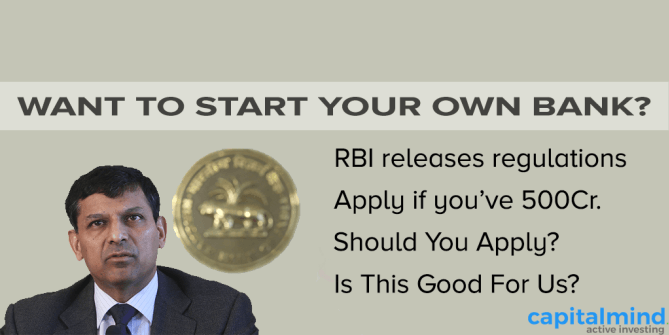How To Start A Private Bank In India – RBI Drafts New Regulations
The Reserve Bank of India has recently announced how banks can be opened. This informative article has been authored by Mastermind, Deepak Shenoy. The original post appears here.

RBI will allow banks to be created “on tap” in the private sector. Meaning if you qualify, you can go apply for a licence – much like a driving licence – and get one. The previous model was: you waited till the RBI told you it wanted people to bid for a licence. This wait could be for 10 years. Then you applied and you waited, usually for two or three years. Then you were told that your fingernails were dirty and please clean them and reapply. And then you died and no one remembered you for it.
Here’s what RBI said in 2013 about How to start a bank in India?
The new process will be less brutal, apparently. These are draft guidelines, released by the RBI today.
What do you need?
- NBFCs that are controlled (not owned) by resident Indians, who have a 10-year track record of success
- Individuals in the finance/banking area with 10 years of experience (Hey, I might qualify!)
- Existing private sector entities with a 10-year successful history, where if they own more than 5000 cr. of assets, then more than 60% of the assets and income should come from the financial domain. (To avoid industrialists creating owned banks)
- Promoters should be “fit and proper”. No wilful defaulters, no Jignesh Shahs etc.
- Capital needed : Rs. 500 crores – and a continued net worth of Rs. 500 cr. at least.
- Promoters should own 40% of the bank at least, and if they own more, they have to bring it down to 40% in five years.
- No one else gets to own more than 10% voting rights in a bank
What can a Bank do? What does it have to do?
Truckloads of regulatory needs have to be met. Banks can borrow from depositors and lend to borrowers, and make the spread. They can access the RBI repo window, all the inter-bank transaction windows, and borrow overnight for liquidity directly from the RBI. They can offer cheque payments, NEFT, IMPS and other such modes. They can offer corporate accounts, credit cards, forex services and trading.
But a bank has to meet regulatory needs like:
- Meeting priority sector lending requirements
- Keeping about 1/5th of all deposits in government bonds
- Maintaining Basel-level capital ratios
- Reporting to RBI about all activity – more than 100 reports submitted regularly
- Ensuring financial inclusion – from geography to gender to low income etc.
- Keeping rates transparent and adhering to the MCLR mechanism
- and so much more.
Is This Fun? Should I Apply?
Why not? It’s tax-free and most importantly, you will learn from the process that you necessarily need to have Rs. 500 crore lying around. The “on tap” doesn’t mean that it flows like beer – you have to demonstrate you can pay the cover charge first.
How Does It Change Life for Banks?
Eventually, this means that banking will no longer be restricted to the top few names you keep hearing of. But to drive them out of business, the new banks have to eat at their franchise and make it so technologically simple to bank that people migrate. They’ll have to lend at lower rates, borrow at higher rates, and squeeze margins.
Banking is going to get tougher, but what this will do is ensure that “bad banks” can be replaced by newer, smarter banks who don’t have the “NPA baggage” that will otherwise lead to a zombie banking system. Hopefully the next breed of banks are more responsive and keep prices low for a long time.





